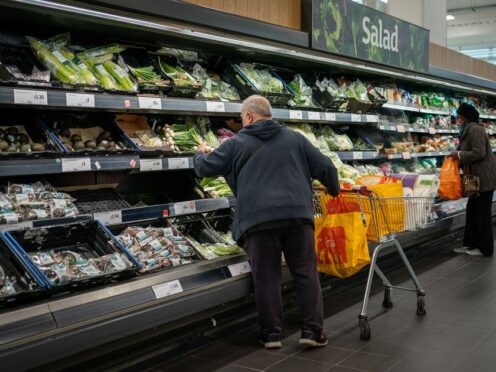
UK inflation fell back by more than expected last month to the lowest level in more than two years as the growth in food prices eased for cash-strapped households, official figures have shown.
The Office for National Statistics (ONS) said that Consumer Prices Index inflation stood at 3.4% in February – down from 4% in January and the lowest level since September 2021.
Most economists had been expecting inflation at 3.5% last month.

Inflation is now closer towards the Bank of England’s 2% target and comes ahead of the latest interest rate decision on Thursday.
Policymakers are widely expected to keep rates on hold at 5.25%, but the steep fall in the CPI is likely to reinforce expectations that the Bank is moving closer to cutting rates later this year.
Grant Fitzner, chief economist at the ONS, said: “Inflation eased in February to its lowest rate for nearly two-and-a-half years.
“Food prices were the main driver of the fall, with prices almost unchanged this year compared with a large rise last year, while restaurant and cafe price rises also slowed.
“These falls were only partially offset by price rises at the pump and a further increase in rental costs.”
The data shows inflation finally resuming its retreat, having unexpectedly lifted in December and then remaining unchanged in January.

Experts said inflation is now likely to fall back below target in April or May, thanks to the scheduled 12% fall in the energy price cap on April 1.
Chancellor Jeremy Hunt said the inflation fall “sets the scene for better economic conditions”, with the UK last month revealed to have slipped into a recession at the end of 2023.
He said: “Inflation has not just fallen decisively but is forecast to hit the 2% target within months.
“This sets the scene for better economic conditions which could allow further progress on our ambition to boost growth and make work pay by bringing down national insurance as we work towards abolishing the double tax on work.”
Commenting on today’s inflation figures, ONS Chief Economist Grant Fitzner said: (1/3) 💬 pic.twitter.com/7fCztP2r1W
— Office for National Statistics (ONS) (@ONS) March 20, 2024
The ONS said it was not seeing any sign yet of an impact on consumer prices from the Red Sea disruption, following attacks from Houthi rebels on cargo ships going through the trade route.
There had been fears that it could push up food costs, as well as prices on clothing and goods, in particular from Asia.
The ONS said any Red Sea impact would likely show first in the trade data, but said it was not seeing any of that coming through in those figures either.
In the year to February 2024:
▪️ the cost of raw materials fell by 2.7%, up from a revised fall of 2.8% in January
▪️ the cost of goods leaving factories rose by 0.4%, up from a revised fall of 0.3%
— Office for National Statistics (ONS) (@ONS) March 20, 2024
The latest data showed annual food price inflation fell back to 5% in February, down from 7% the previous month.
On a monthly basis, food inflation lifted by 0.2% – far lower than the steep rises seen a year earlier.
Prices in restaurants and cafes also eased back, with the annual rate of inflation falling to 6.7% last month from 8.2% in January.
But this was partially offset by rising costs at the fuel pumps, with the average price of petrol up by 2.3p a litre between January and February to stand at 142.2p a litre, though this was still lower than the 148p a litre seen a year earlier.
In the year to February 2024:
▪️ Consumer Prices Index including owner occupiers’ housing costs (CPIH) rose by 3.8%, down from 4.2% in January.▪️ Consumer Prices Index (CPI) rose by 3.4%, down from 4.0% in January.
➡️ https://t.co/ObDycx6pDz pic.twitter.com/f9fuw78dFR
— Office for National Statistics (ONS) (@ONS) March 20, 2024
The latest data also showed the CPI measure of inflation including housing costs (CPIH) fell to 3.8% in February from 4.2% in January, while the Retail Prices Index (RPI) fell back to 4.5% from 4.9%.
James Smith, an economist at ING, said: “A 12% fall in household energy bills due in just under two weeks, should take headline inflation below 2% in either April or May.
“It’s likely to stay below the Bank of England’s target for much of 2024, especially when you consider we may well see another double-digit percentage point fall in energy bills in July when the regulator again updates the household price cap.”
He is pencilling in the first rate cut in August, or possibly as early as June.

Enjoy the convenience of having The Sunday Post delivered as a digital ePaper straight to your smartphone, tablet or computer.
Subscribe for only £5.49 a month and enjoy all the benefits of the printed paper as a digital replica.
Subscribe